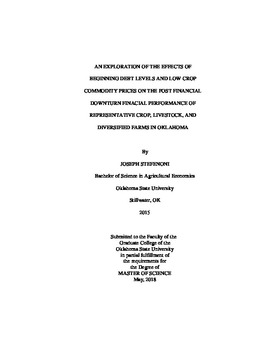| dc.contributor.advisor | Jones, Rodney | |
| dc.contributor.author | Stefenoni, Joseph Brantley | |
| dc.date.accessioned | 2019-03-29T15:39:56Z | |
| dc.date.available | 2019-03-29T15:39:56Z | |
| dc.date.issued | 2018-05-01 | |
| dc.identifier.uri | https://hdl.handle.net/11244/317812 | |
| dc.description.abstract | After historically high levels of net farm income in 2012 and 2013, low commodity and livestock prices have combined with other factors to dramatically reduce farm income. These changes create financial stress for farmers, degrade the value of farmland and other farm assets, and have implications for agricultural credit markets and relationships. Most farmers and ranchers are looking for ways to improve financial performance, but more importantly are looking for information on how to mitigate the effects of financial stress in their operations. Active farmers and ranchers need information to survive the current and future periods of farm financial stress. The purpose of this research is to explore the extent of recent farm financial stress, and to determine what factors are contributing to the current cycle of farm financial stress. Specifically, recent trends in farm income and farm debt are explored, current farm financial position and performance is compared to previous years, and factors are determined that are associated with successful transition through periods of farm financial stress. This research examines the effect that leverage, and prices have on the intermediate survival of a farm business. A representative crop farm, cow-calf farm, and diversified farm are created from data that represent the average for all Oklahoma farms. The farms are evaluated at a low, medium, and high leverage position then simulated 10 years into the future. The debt-to-asset ratio at the end of year 10 is used to determine if the farm had a better or worse financial position. If the farm has a higher debt-to-asset ratio at the end of year 10, then it will be simulated through six different management scenarios. The research found that prices and the total amount of debt have a significant impact on farm financial health. | |
| dc.format | application/pdf | |
| dc.language | en_US | |
| dc.rights | Copyright is held by the author who has granted the Oklahoma State University Library the non-exclusive right to share this material in its institutional repository. Contact Digital Library Services at lib-dls@okstate.edu or 405-744-9161 for the permission policy on the use, reproduction or distribution of this material. | |
| dc.title | Exploration of the Effects of Beginning Debt Levels and Low Crop Commodity Prices on the Post Financial Downturn Financial Performance of Representative Crop, Livestock, and Diversified Farms in Oklahoma | |
| dc.contributor.committeeMember | Riley, John Michael | |
| dc.contributor.committeeMember | Holcomb, Rodney | |
| osu.filename | Stefenoni_okstate_0664M_15745.pdf | |
| osu.accesstype | Open Access | |
| dc.description.department | Agricultural Economics | |
| dc.type.genre | Thesis | |
| dc.type.material | text | |
